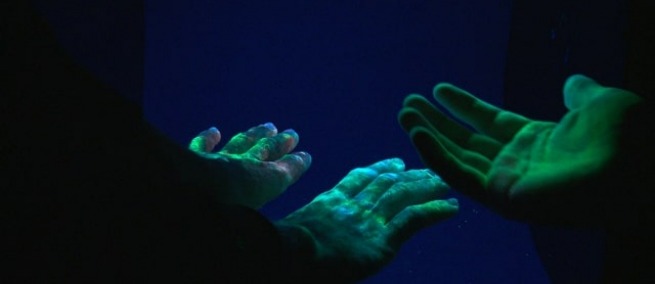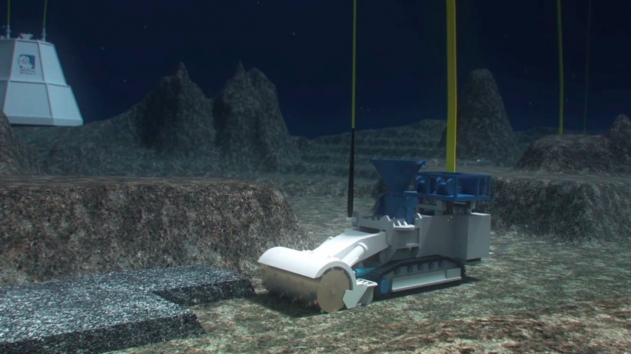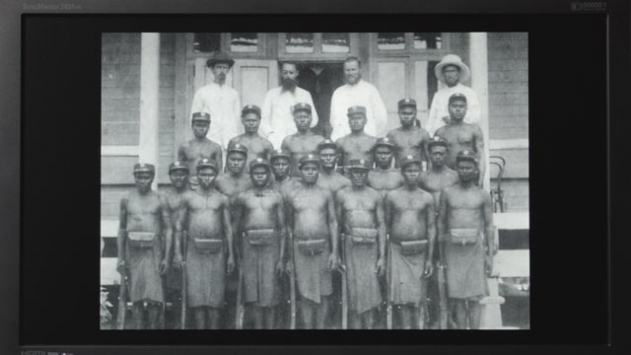
When I was spending time at sand mines in central Java in 2016, it was common to see offerings of juices, drinks, tobacco, fruit, and even fried noodles around. Some offerings were being used for activism against the mines. The mines were mostly illegal and inevitably destructive. Sand was shipped as far away as mainland China to feed its building boom. Much of it also ended up in fresh concrete in Jakarta’s housing towers because sand helps to strengthen mortar. The mines were operated by shadowy businesses and often protected by thugs. Villagers suffered the effects of the mining—noise, destruction of water sources, the destabilising economic effects of quick money pouring into communities. As a result, they began to draw on spiritual resources for help. The offerings were a way to conjure more-than-human support from deities who lived in the landscape in their struggles against the mining.
As one might imagine, mining is alienating. It transforms landscapes into dead things, objects to be sold. Giving offerings, on the contrary, was a way to conjure and enlist the presence of spiritual beings. But these spiritual beings were not merely supernatural, ghost-like beings, they were ancestors or the spirits of historical persons who had once lived around the mines; or, they were figures of historical importance in Indonesian struggles against colonialism. In other words, spirits were histories that connected people to land and much broader political and social narratives about the place.

Film still from EUROPIUM, courtesy of Lisa Rave
One evening I joined a ritual meal staged in front of an active mine. The participants conjured these local deities to intervene in the mining. It was, in part, an attempt to create spiritual solidarity, but it was also to conjure a sense of endangered worlds for the miners, to remind them that they were not working in a space devoid of history or meaning.
Spiritual activism around mining is not new. The term fetish came into its modern usage in the fifteenth century when Portuguese traders looking for gold on the west coast of Africa encountered Black cultures for the first time. The Portuguese began to refer to amulets and other objects as feitiço. In their Christian worldview, the traders could not admit that worldly objects could have metaphysical agency. When Dutch slavers and traders later entered the scene in the sixteenth century, the term took on a new meaning by enabling them to identify objects of value to their commercial interests. They opposed fetishes to ‘trinkets’ and ‘trifles,’ and most crucially, gold. In their Calvinist cosmology, fetishes were valueless superstitious objects, but gold was naturally endowed with value because of its exchangeability. Belief in fetishes, according to Dutch traders, was the result of misunderstanding the true value of objects such as gold and, ultimately, a sign of cultural primitiveness.
Famously, Marx turned this interpretation on its head. He was fully aware, in the 1860s, of the arguments European traders and slavers had used to cast non-European cultures as primitive. In the first volume of Capital, he applied the argument to European society. Industrial capitalism, he wrote, was foundationally fetishistic. People in a capitalist culture attributed spiritual powers to money. Capitalists believed that economies could ‘grow,’ as if they were a biological thing. They thought that money magically reproduced itself, that commodities attracted us, cast spells over us, and energized us. Capitalists even thought that their private property was an embodiment of their deepest self. Marx even attacked the fashion of the time for spiritualism and table turning—the precursors of the Ouija board—where people thought that they were contacting dead ancestors. Capitalism was the true magician, he argued; the metaphysical powers of capitalism far outshone the work of any séance. The real nature of commodities, in Marx’s view, was not that they were made up of relationships between people and objects but relationships between people and people. The fetish of the commodity obscured the reality that people, in real places and times, made them. Moreover, the ownership of commodities entrenched social relations; people with more commodities could wield social power over people with less. In other words, commodities were social relations.
This argument was re-applied to mining by Michael Taussig in the 1970s. During fieldwork in Colombian tin mines, much like Skeat had in Malaya, Taussig found a community at the frontier of industrial capitalist processes. Also like Skeat, Taussig learned that the miners understood that mountains were bodies, and that minerals and ores were alive. It was a world in which pre-capitalist forms of sociality persisted. People could still remember the deep connections between persons and environments. Miners knew that social life could be organised around leisure, not wage labour, and that life was dependent on negotiations with spiritual entities who lived in the mines. Surprisingly, in these tumultuous conditions, Taussig found devil worship. He came to understand that the devil was being given offerings of flowers, booze, and cigarettes at the face of the mine. It became clear that devil worship was a way of making sense of the painful transition from small scale, subsistence artisanal mining into commodity capitalism. The miners thought that fetishizing commodities was the devil’s work. More broadly for Taussig, the insight of his miner friends was to reveal that capitalism, by nature, was magical; it required tremendous efforts of fabulation and fantasy. The problem was not how to create a world without magic, but to harness the capacity of fabulation as a critical tool for explaining the conditions we find ourselves in.

Film still from EUROPIUM, courtesy of Lisa Rave
In EUROPIUM, Lisa Rave, reminds us that mining is still a privileged site for understanding magic, minerals, and capitalism. Europium is a rare earth element ubiquitous in our everyday objects; it makes the screens on our phones and televisions brighter, and it is even used in the Euro currency bills to create a luminous shine that reduces counterfeiting. Europium exudes the fetishistic qualities of modern commodities. It is mined from the seabed and made of the ancient bodies of shells accumulating over deep time.
What EUROPIUM traces is not the connection between mining and fetishism but another linked concept, animism. Like fetishism, animism was a category created by Europeans to explain other cultures in colonial conditions. The British anthropologist Edward Tylor developed the term in the 1910s in Primitive Culture, a book that sought to explain at a global scale the stages of religious beliefs from the primitive to the modern. Tylor based much of his work on the accounts of Europeans in faraway lands—he was not one for fieldwork—and his idea was that religious systems evolved in stages. Monotheism was the most recent advancement and, especially so, a scientifically informed Christianity. Animism, in his system, was the most first and most primitive form of religion because it believed in all pervasive and immediate spiritual agencies. For Tylor, animists were living relics of a prior age. While it is easy enough to underline the racist assumptions and violent consequences that these ideas enabled, it is worth acknowledging that, for Tylor, animism was also fundamentally European, Christian, and modern. Progress was not simply a linear shirking off of old ways of thinking. Like Marx, Tylor also turned the colonial view on its head. In a telling passage in Primitive Culture he wrote, “the scientific conceptions current in my own schoolboy days, of heat and electricity as invisible fluids passing in and out of solid bodies, are ideas which reproduce with extreme closeness the special doctrine of Fetishism.”[1] He returned again and again in Primitive Culture to examples that demonstrated how animism was pervasive in the modern world. It was woven through Catholic and Anglican fascination with idols, it was in the worship of the al-Ḥajaru al-Aswad black meteoritic stone in the Kaaba, it was even in views of people about sacred rocks, trees, whirlpools, and streams that fanned out from his patrician little town of Oxford. Animism was not ‘over there,’ it was at the very heart of religious meaning making. Tylor’s comparative anthropology set up the very possibility of this manoeuvre: the advanced does not leave the primitive behind, the primitive is inside the advanced, the monotheist contains the animist. The categories break down. By looking at far-away cultures, Tylor came to understand how his own culture was much more like them than many people were comfortable to admit at the time. Like Taussig’s devil in the tin mine, thinking about animism allows us to undermine conventional narratives of linear progress and that rational beliefs supplant irrational ones.

Film still from EUROPIUM, courtesy of Lisa Rave
My friends who have had to struggle with their rivers being destroyed by sand miners were the first to teach me that ideas about spirits in mines were thoroughly contemporary, political, and urgent. It was on the bridges overlooking the miners working in front-end loaders hacking at the riverbanks that I came to understand that what was at stake were definitions of what sand is. Is it the home of an ancestor who could make demands on you, to whom you had to give gifts and pay respect to, or is it a dead, speechless thing that could be exchanged for money? It was on these same bridges that I also came to understand an unsettling reality about living under modern capitalism: it is not only fetishistic and animist, it is also haunted.
If I was to take my friends seriously and understand that sand contained their ancestors, then that meant that the newly built apartment I lived in in Jakarta likely contained their ancestors, too. It is probable that the building was made with material carted away from their mines. The new restaurant I recently ate at in Bali probably also contained sand from there mixed into its concrete walls. The same is true for buildings throughout Singapore and southern China. The ancestors which have been carted away by the miners are inherited by unsuspecting people like me who live with their displacement. This means that I am haunted by my friend’s ancestors. The work is learning how to see them and live with them. EUROPIUM shows us this fact, too. In our luminescent money, we inherit traditions of thought from the south Pacific that also once used shells as money. Lisa Rave’s film compels us to ask one of the most troubling questions of our time, how do we come to inherit and live with the ancestors of others?
[1] Edward Tylor, Primitive Culture: Researches into the Development of Mythology, Philosophy, Religion, Language, Art, and Custom (London: John Murray, 1913), 160.
TOPICS